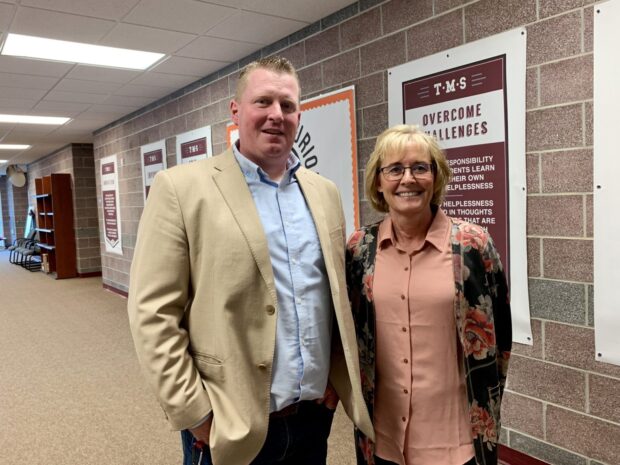DRIGGS — Brian Ashton had a clear message for state education leaders last year: “Bring it on.”
“We’re not afraid to grow,” the 42-year-old Teton Middle School principal wrote in an August 2018 Teton Valley News op-ed.
The State Department of Education last year named Teton one of Idaho’s 29 lowest performing schools, citing low math scores.
Ashton owned up to his school’s place on the list, yet vowed a turnaround.
A year later, the principal touts major gains in the same math scores that landed the school on the 2018 list of low performers.
The key to improving this year’s scores? Reducing student testing requirements, Ashton said. “We had to simplify.”
Flagged for low performance
The SDE last year listed Idaho’s lowest performing schools as part of a new accountability plan.
Educators offered various reactions to the report. Madison School District’s outspoken superintendent, Geoff Thomas, lambasted the “public shaming method” and called for an apology from the state.
Ashton shared publicly his plans for improving Teton’s dismal math scores. In 2018, fewer than 20 percent of the school’s students achieved proficient scores on the math portion of the state’s standardized test of choice, the Idaho Standards Achievement Test. Statewide, 40 percent of students in the same grades reached proficiency.
Presenting an improvement plan was one requirement for low-performing schools. Other objectives and resources included:
- On-site placement of “capacity builders” at each low-performing school to consult leadership teams in developing and implementing turnaround strategies.
- Schools serving low-income families and classified as Title I split $2.1 million in federal funding designed to help low-performing, low-income schools improve. Teton’s share of the pie: $138,001.
Reducing testing requirements
Teton’s assigned capacity builder, Anne Seifert, worked with Ashton and the school’s leadership team to develop an improvement model.

Both Ashton and Seifert said a clear roadblock to improvements surfaced early on: Teton middle schoolers were taking too many tests.
For years, the school has administered two annual standardized tests to students:
- The MAP Growth test, which the district required in order to measure knowledge and guide future instruction.
- The ISAT, Idaho’s Common Core-rooted standardized test of choice.
An overemphasis on the MAP exam was fueling an underemphasis on the ISAT and overloading students — especially those with limited learning abilities, Ashton said.
Ashton “did the kids a solid” by convincing Teton trustees to drop the school’s MAP testing requirement. The move both simplified the testing process for kids and paved the way for teachers to focus more on teaching standards aligned with the ISAT, Seifert said.
Improved ISAT scores
Reducing testing requirements preceded a major jump in this year’s ISAT scores.
On average, Teton’s proficiency on the math portion of the ISAT climbed from last year’s 18.2 percent to 28.1 percent in 2019.
And an even bigger improvement surfaced in ELA, where average proficiency soared from 31.9 percent in 2018 to 51.5 percent proficiency in 2019.
Statewide, 45 percent of students reached proficiency on the 2019 math portion of the ISAT. Nearly 56 percent reached proficiency in ELA.
‘We still have a ways to go’
Ashton acknowledged that, despite this year’s big gains on the ISAT, Teton students still trail their statewide peers in both math and ELA proficiency.
“We still have a ways to go,” he said.
Still, the surge in scores fuels hope that the school can continue to improve.
“We have the brains to solve the problem,” Ashton said.
Testing student knowledge is also one component of accomplishing the school’s larger mission to promote safety, innovation, self-efficacy and help kids realize their potential, Asthon added.
Clad in a tan sports jacket and jeans, he pointed to a banner bearing the statement above the school’s main entryway.
“(Testing) is just one piece of it all,” Ashton said.
